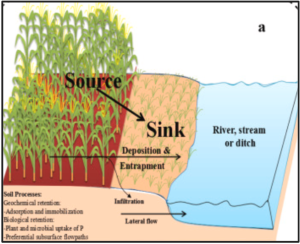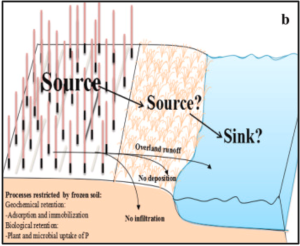40 Impact on Water Quality and Human Health: Agricultural Runoff
What is Agricultural Runoff?
Agricultural runoff refers to the movement of water—typically from rainfall or irrigation—across farmland rather than into the soil. As this water travels over the land, it collects substances such as fertilizers, pesticides, and animal waste that were initially intended to support plant growth. However, when these materials are carried away from the fields, they often end up in nearby rivers, lakes, and streams (Hall, 2024). (CK)
This process introduces pollutants into natural water systems, leading to environmental degradation and declining water quality. Over time, agricultural runoff can contribute to harmful algal blooms, oxygen depletion in aquatic environments, and contamination of drinking water sources. It is one of the most significant contributors to non-point source pollution and represents a major challenge for both environmental protection and sustainable agriculture. (CK)
How does Agricultural Runoff occur?
Agricultural runoff often depends on the condition of the soil—specifically, how well it can absorb and retain water. A key part of this process is soil filtration, which refers to the soil’s ability to allow water to pass through while still holding onto essential nutrients and agricultural inputs (Hall, 2024). (CK)
2.1 – What Ideal Filtration Looks Like
In well-managed agricultural systems, soil is healthy and rich in organic matter. These qualities allow water to seep into the ground rather than running off the surface. Good soil structure includes small spaces between particles that help water soak in, where it can reach plant roots and support groundwater recharge. (CK)
However, ideal filtration is not just about how water moves—it is also about how nutrients stay in place. Healthy soil holds onto essential nutrients in two important ways. The first is through geochemical retention, where soil particles attract and cling to nutrients like phosphorus, preventing them from washing away. The second is biological retention, where plant roots and soil microbes absorb and recycle nutrients, keeping them available for future growth (Stoner et al., 2015). (CK)
Together, these processes help create a system where water and nutrients are used efficiently and stay where they are needed most Figure 2 shows what this kind of healthy soil environment looks like: water is absorbed evenly, and the land continues to support both crops and long-term sustainability. (CK)

2.2 – What Poor Filtration Looks Like
When soil quality is compromised, its ability to absorb water diminishes significantly. This degradation often occurs in areas where the land has been overworked, where vegetation has been removed, or where heavy machinery has compacted the soil. As a result, the soil structure becomes dense, and water no longer seeps into the ground. Instead, it pools on the surface and flows away as runoff. (CK)
This runoff carries more than just water; it also transports fertilizers, pesticides, and other chemicals that were applied to the soil for crop growth. Since the soil can no longer retain these substances, they are easily washed into nearby water bodies. This can lead to water pollution, disrupt aquatic ecosystems, and contribute to larger environmental issues, such as algal blooms and contamination of water supplies (Al-Kaisi, Soil Erosion: An Agricultural Production Challenge). (CK)
Soils that lack sufficient fertility and vegetation cover are particularly vulnerable. Without plant roots to hold the soil together and organic matter to keep nutrients in place, these areas become more susceptible to erosion, nutrient loss, and long-term environmental damage. Figure 3 depicts these conditions, showing how compacted and dry soil fails to retain water, leading to further runoff and pollution. (CK)

